Souvenirs from Japan are the best in this entire world. I can’t express how many things we ended up buying from Japan, from wooden items, through interesting Japanese fans, to fridge gadgets.
During our first 2 weeks in Japan, we collected an array of exciting items and even sent some in the post. During our second trip to Japan, we flew with almost empty bags, so we can fill them in with all sort of cool souvenirs from Japan. Although Japan is not just a shopping destination, it’s a surreal place where you’ll find so many interesting things you’ll want to buy them all.
Here are the souvenirs from Japan you absolutely need to buy.
Table of Contents
- Souvenirs from Japan
- Traditional Japanese items
- Japanese Fans
- Japanese Yukata
- Chopsticks
- Noren
- Furoshiki
- Kimono
- Silk Scarves
- Traditional Craftwork
- Japanese Knife
- Japanese Incense
- Furin Wind Chimes
- Japanese Omamori
- Japanese Ema
- Origami
- Japanese Masks
- Neko Figurines
- Food & Drink
- Matcha sweets
- Rice Crackers
- Jams
- Pickle plums
- Salted Sakura
- Japanese Teas
- Seaweed from Japan
- Black Sesame
- Mochi
- Box of Wagashi
- Jellies
- Sake from Japan
- Japanese whisky
- Japanese umeshu
- Japanese Stationery
- Erasers
- Pen Holders
- Pens and pencils
- Cute clips
- Stickers
- Kitchen Items
- Ramen Bowl
- Sesame Suribachi
- Miso Bowl
- Steamer
- Tea Holder
- Bamboo chopstick holder
- Sake cups
- Cute Japanese plates
- Bowl tops
- Special Japanese Items
- Anime figurines
- Heat Patches
- Eyeliner
- Mascara
- Toe Socks
- Face Masks
- Kawaii Souvenirs from Japan
- Phone cover
- Cute outfits
- Plush Toys
- Squishies
- Vibrant Hair Dye
- Hair accessories
- Frequently Asked Questions
Souvenirs from Japan
Our favourite souvenirs from Japan are the unusual things you can only find in the country. We’re not talking about magnets for your fridge or mugs from Starbucks. We’re talking about traditional items which will add soul to your home. For example, we purchased a sushi knife, which will forever remind us of the fantastic food in Japan.
We bought a talking fridge gadget in the shape of a penguin, which talks to us every single time we open our fridge door. We purchased norens, ramen bowls, sesame grinder (I will explain, I promise), miso bowls, chopsticks, cards, fans, clothing items, ah, the list can continue forever. Our family and friends love their souvenirs from Japan as well, and they continue to tell us that thus far, the things we buy in Japan are the absolute best in the world. We can’t agree more.
Here’s a list with everything you need to buy from Japan, so you can return home with some of the best souvenirs in this entire world.
Traditional Japanese items
Whilst we love buying food items, we know that some of our friends and family like items which are not perishable but last for a lifetime.
As already mentioned, we are not going to suggest buying a magnet, but something a lot more precious and exciting. One of the main things we recommend as souvenirs from Japan are the mighty chopsticks. We are not talking about the 100 yen ones you can find at any corner, but the exquisite ones you can find when shopping in Ginza. The thing is, some Japanese actually carry their chopsticks with them, and they represent a lot more than just an object meant for eating purposes. Some are handmade, beautifully painted, incredibly well done.
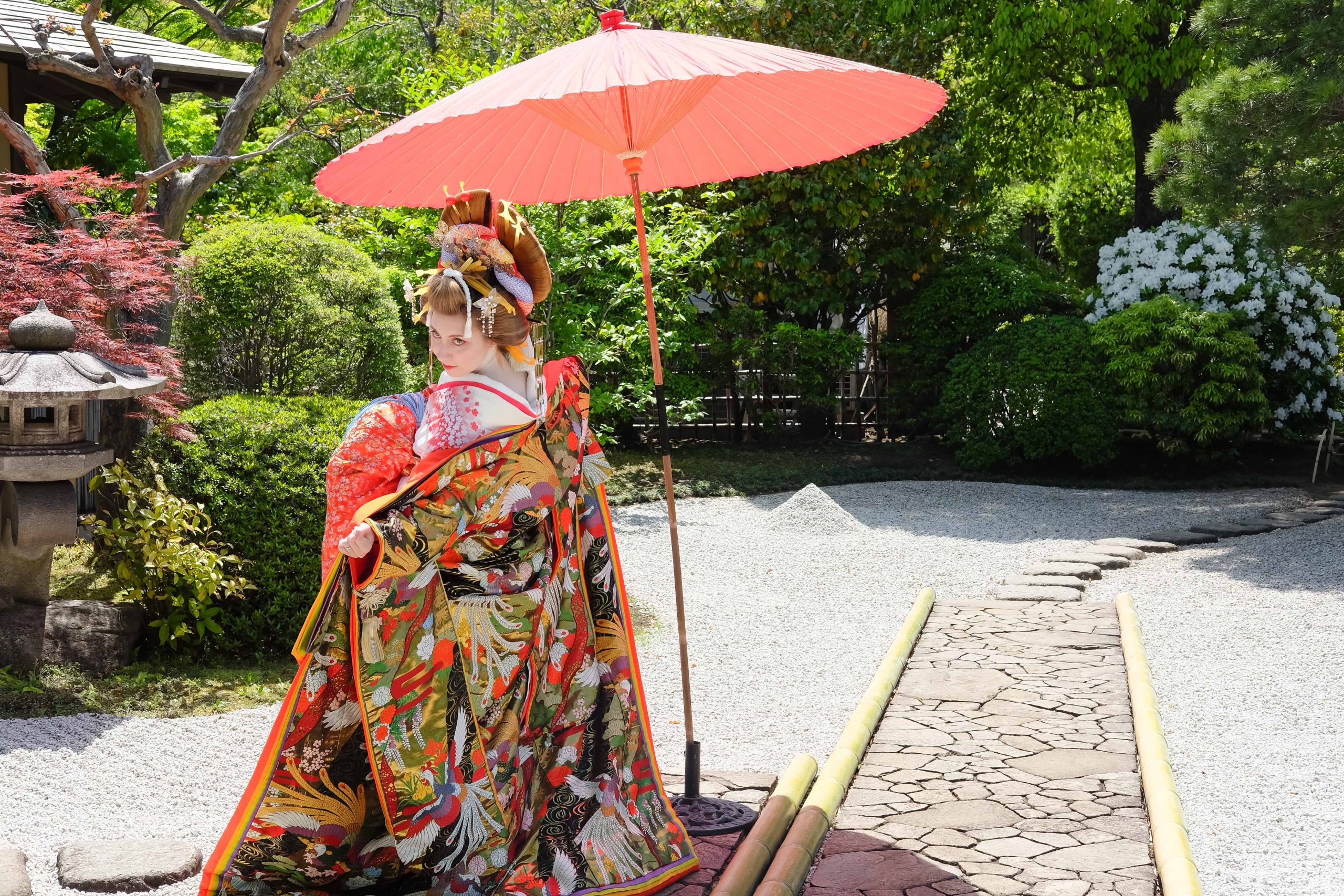
Japanese Fans
Who doesn’t love a beautiful Japanese fan? We purchase two types of Japanese fans: a folding fan called Sensu and a rigid fan called Uchiwa. These were used for various ceremonies and continue to be used today by Geishas and actors in Kabuki. If you want to play with them, book a wonderful Japanese kimono experience near Tokyo and learn about them.
Japanese Yukata
Yukatas are Japanese garments made of cotton. Think of it as a more casual kimono. You will very likely find them in your ryokan if you decided to experience a Japanese onsen. They come in different colours and sizes for men and women. They are very comfortable and easy to use. In certain onsen areas, you will find locals going out in yukatas. Is it cultural appropriation to wear a yukata? Locals in Japan say no. They actually appreciate when foreigners try to integrate and adhere to onsen guidelines. Yukatas make for great souvenirs from Japan: they are timeless and unique.
Chopsticks
As previously mentioned, chopsticks are perhaps the best souvenir from Japan. It’s also practical for those who love Asian food at home. We bought our unique chopsticks from Ginza, but also bought several cheap sets with various Japanese art on them. You can find them for as little as £1 in various stores, and it’s such a simple item your friends and family will love.
We found a great shop in Ginza called “Natsuno” selling all kind of chopsticks. Prices ranged from very affordable few dollar pieces to handcrafted, special items selling for $3000. We write a whole article about the experience we had in the shop.
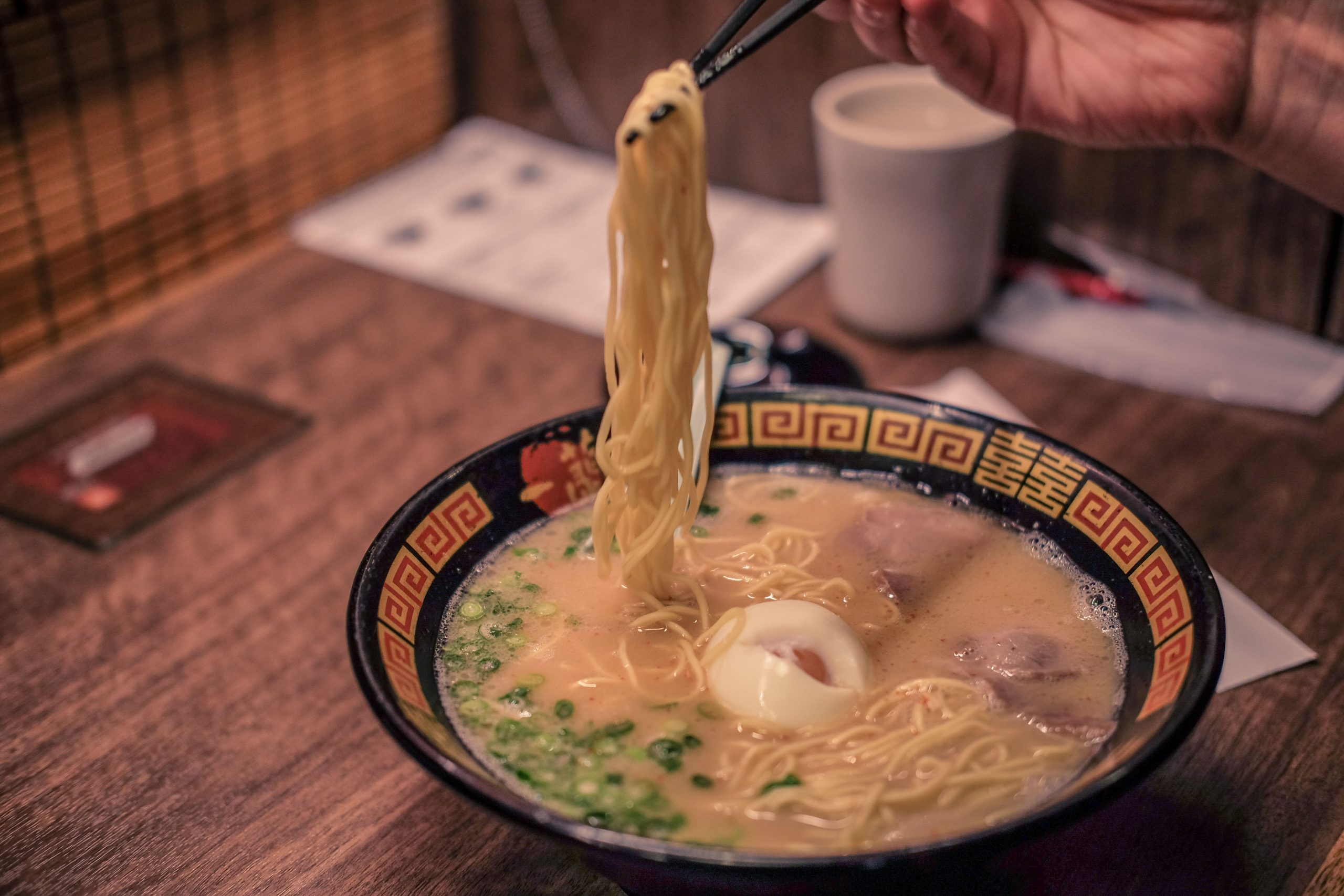
Noren
A noren is a traditional Japanese fabric which acts as a divider. You will find them at the entrance of most traditional restaurants or even in your ryokan. We found a beautiful noren close to Asakusa, which depicts The Great Wave off Kanagawa. These are affordable items which are easy to fold in your luggage. They really are traditional and representative. We use our noren as a room separator in one of our bedrooms. It looks fantastic, and it reminds us of the incredible time we had in Japan.
You might have seen norens on the outside of a shop or restaurant. They are meant to protect from sun or wind, and it’s also an excellent way to display the business name. You can use norens for practical or decorative purposes too.
Furoshiki
A Furoshiki is a traditional Japanese cloth used to transport clothes or gifts. We like to wrap sweets in Furoshiki before giving them to friends and family. There is a special store in Tokyo called Oriental Bazar, close to Omotesando Hills. You can find many Furoshiki there.
And before you ask, yes, there is a proper way of wrapping a gift in a Furoshiki. You can watch several tutorials on how to do it and learn a new Japanese skill. If you purchase a food item as a souvenir from Japan, you can then wrap it in a Furoshiki to make it look even more special and wonderful.
Kimono
If your budget allows it, buying a traditional kimono is perhaps the ultimate souvenir from Japan. Japanese kimonos are expensive, but they are true pieces of art which can last for generations. They are fine and suave to touch. If you don’t wish to purchase a real kimono, you can always dress up as an oiran or samurai for a day, and to experience wearing one.
If you ever wondered, kimono actually means “thing to wear” in Japanese. Kimonos range in formality from casual to formal, for special occasions. Contrary to common belief, kimonos as not made from silk only, but from a variety of fabrics like hemp, linen, and crepe too.
For a high-end artisanal kimono, you can expect to pay anything between $30,000-$50,000. That’s an investment, for sure.
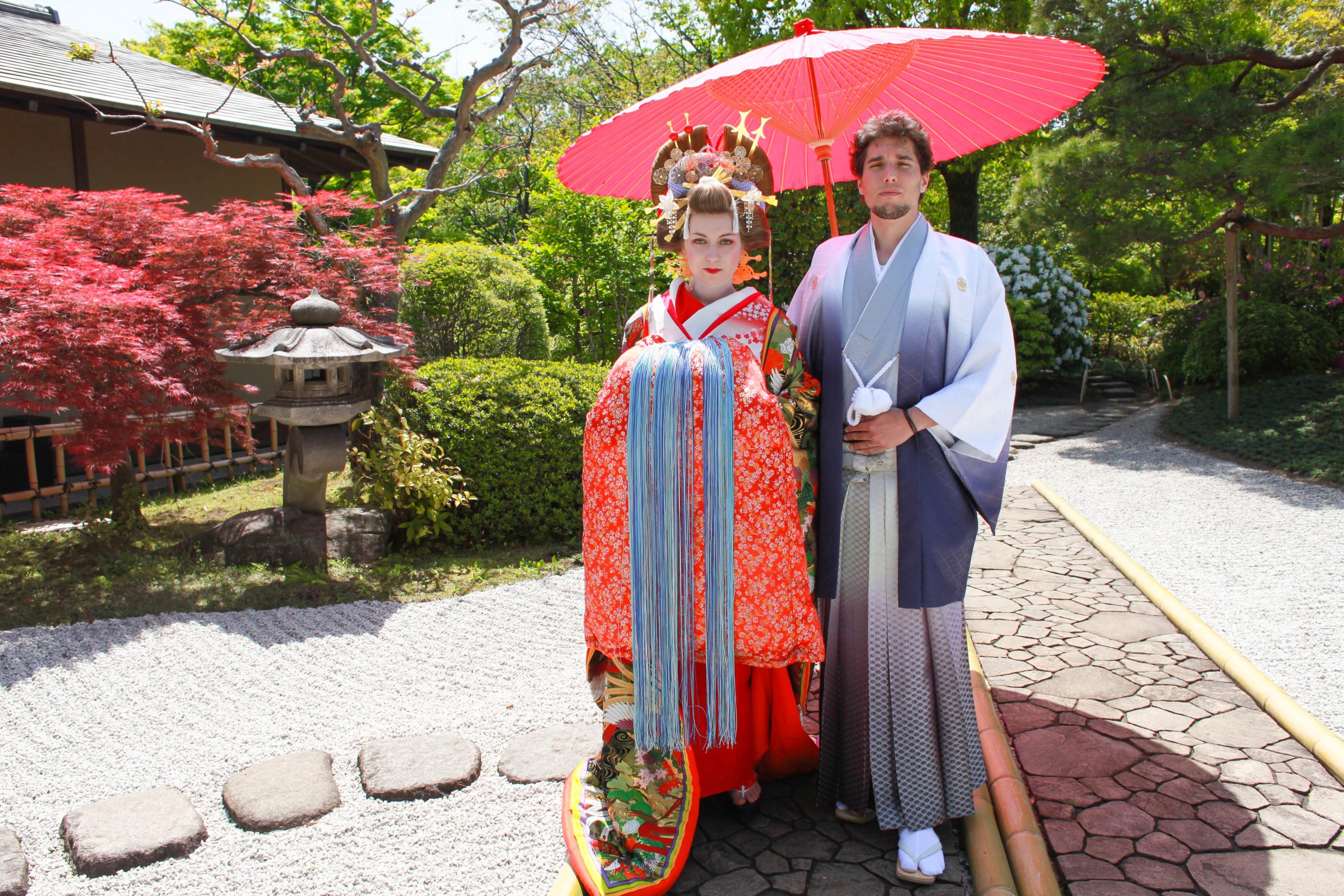
Silk Scarves
There is something so special about buying a silk scarf as a souvenir from Japan. We purchased two silk scarves, both of them from the Oriental Bazar in Tokyo. They had geishas on them and looked so fine and feminine. A truly traditional masterpiece.
What is so special about silk in Japan? Legend has it that a Chinese Empress Leizu discovered silk by mistake in 2700 BCE. Silk arrived in Japan in the 4th Century via Korea.
Mulberry silk is the most common type and Nishijin Ori is the best quality silk.
Traditional Craftwork
Why not look for Edo Kiriko glass or Arita Yaki porcelain? These are made using traditional methods and look absolutely spectacular. They are very delicate, so make sure to wrap them properly when transporting them back home.
Edo Kiriko, is a special Japanese method in which delicate patterns are cut into the glass.
Rumour has it that Edo Kiriko was founded in 1834 by Kagaya Kyubei and his way of making the glass spread all throughout Edo (now Tokyo).
Japanese Knife
My husband is obsessed with Japanese knives and during our 7 days in Tokyo, we visited so many special knife stores. Eventually, he found one he loved and he still uses today. They are known to last forever and to be incredibly sharp.
If you love making sushi or want to become good in the kitchen, we strongly recommend getting a chef’s knife as a souvenir from Japan.
Important to check rules & regulations regarding carrying knifes in your luggage.
Japanese Incense
I love incense sticks, and nowhere in the world you will find better incense than in Japan. In Tokyo, there are specialized incense stores which look simply stunning. Imagine walking into a minimalistic store, which has colourful boxes of incense arranged strategically to appeal to you visually. They are also presented under glass panels to make them look expensive and exquisite.
Once you can decide on a colour and smell (it can take hours!), the shopkeeper picks up the box with the utmost care and wraps it beautifully for you. When purchasing high-end Japanese incense, it’s an experience, which comes with incredible customer service.
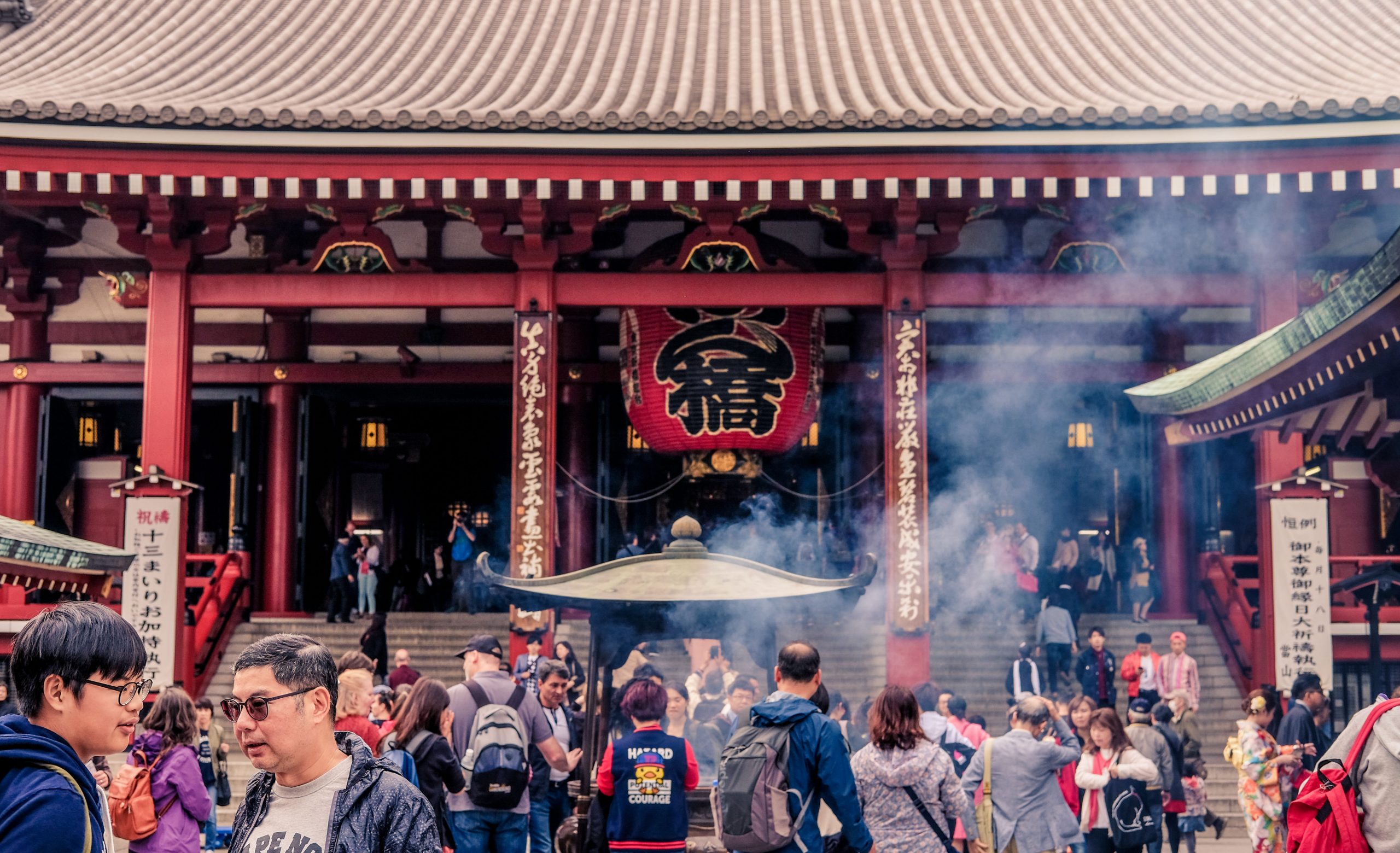
Furin Wind Chimes
A furin is a wind chime. Some of them look like beautiful glass globes with special items inside them, like a mini Mount Fuji. I love wind chimes, and Japan has some of the most aesthetically pleasing ones. They are also very cleverly done, as they are usually painted on the inside of the glass to protect the colours. You can find them in specialized stores in Ginza, Tokyo.
Love a little history about your souvenir from Japan? Well, wind chimes were actually a fortune-telling tool in China. Depending on the wind direction and the sound the wind made when hitting the bell, they would know what’s coming. In Japan, however, they were used to scare evil spirits away.
Japanese Omamori
Omamori is a Japanese amulet usually sold at Shinto shrines or Buddhist Temples. They are dedicated to particular gods (kami) and they are meant to protect you from evil spirits. You can purchase them around spiritual sites, and they make a wonderful and unique souvenir from Japan.
Omamori are made sacred through the use of ritual at the local shrine or temple. You can get these amulets made of silk but also paper and use. However, nowadays omamori comes in all sort of shapes and forms. You can find them as reflectors for your bike, or even as stickers for your car or little amulets for your smartphone.
Here’s something to remember if you decide to purchase an omamori as a souvenir from Japan: You should not open your omamori, or the protective spells will wear off. While it’s not necessary, some people like to replace omamori every year at New Year’s Eve, so they start the year with a new spell.
Do you want to get rid of your old omamori? Do not throw it away! You must burn it as a sign of respect towards the deity that protected you throughout the year.
Japanese Ema
This is one of my favourite souvenirs to bring home from Japan: an ema. An ema is a wooden plaque where people write down their wishes and leave them behind at temples for the gods to take care of them.
They can be purchased at most shrines, and they usually have the kami representation for that particular shrine. We purchased a few from one of the shops located next to Fushimi Inari Shrine, as they were ema in the shape of a mini torii gate. We left a couple behind at the shrine with our wishes, and brought the rest home as souvenirs.
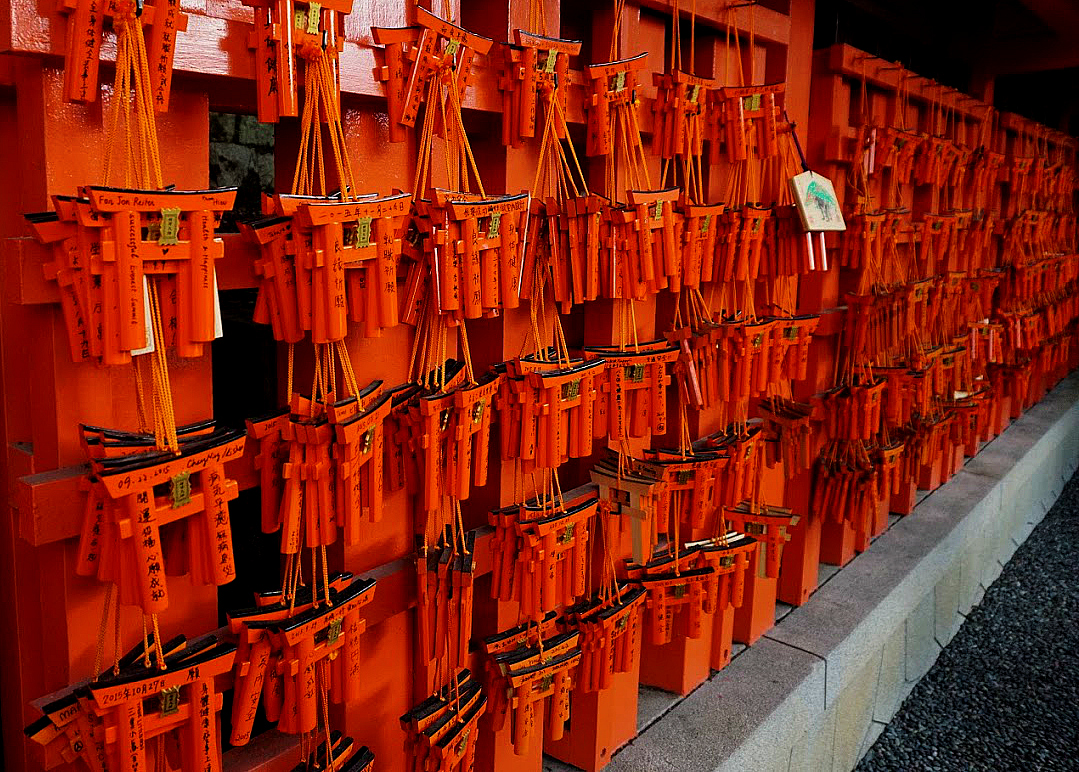
Origami
Origami is the art of folding paper and is deeply associated with Japanese culture. You can find various origami items made with special paper. The crane is perhaps the most popular item, although you can find various modern figures as well.
Did you know you can sign up for origami classes while in Japan? I said it times and times again, but experiences are usually the most magnificent souvenirs from Japan. You can then purchase origami paper from Japan and make origami for your family and friends. Or even have an origami dinner with Japanese sweets and awesome travel stories.
Japanese Masks
There are so many Japanese masks you can purchase, including samurai masks, festival masks, “noh” masks etc. They play an important role in Japanese culture and if attending a matsuri in Japan you will inevitably see people wearing them.
These masks are unique and make a fantastic Japanese souvenir. Some masks are used for decoration, whilst others are thought to frighten bad spirits and bring good luck.
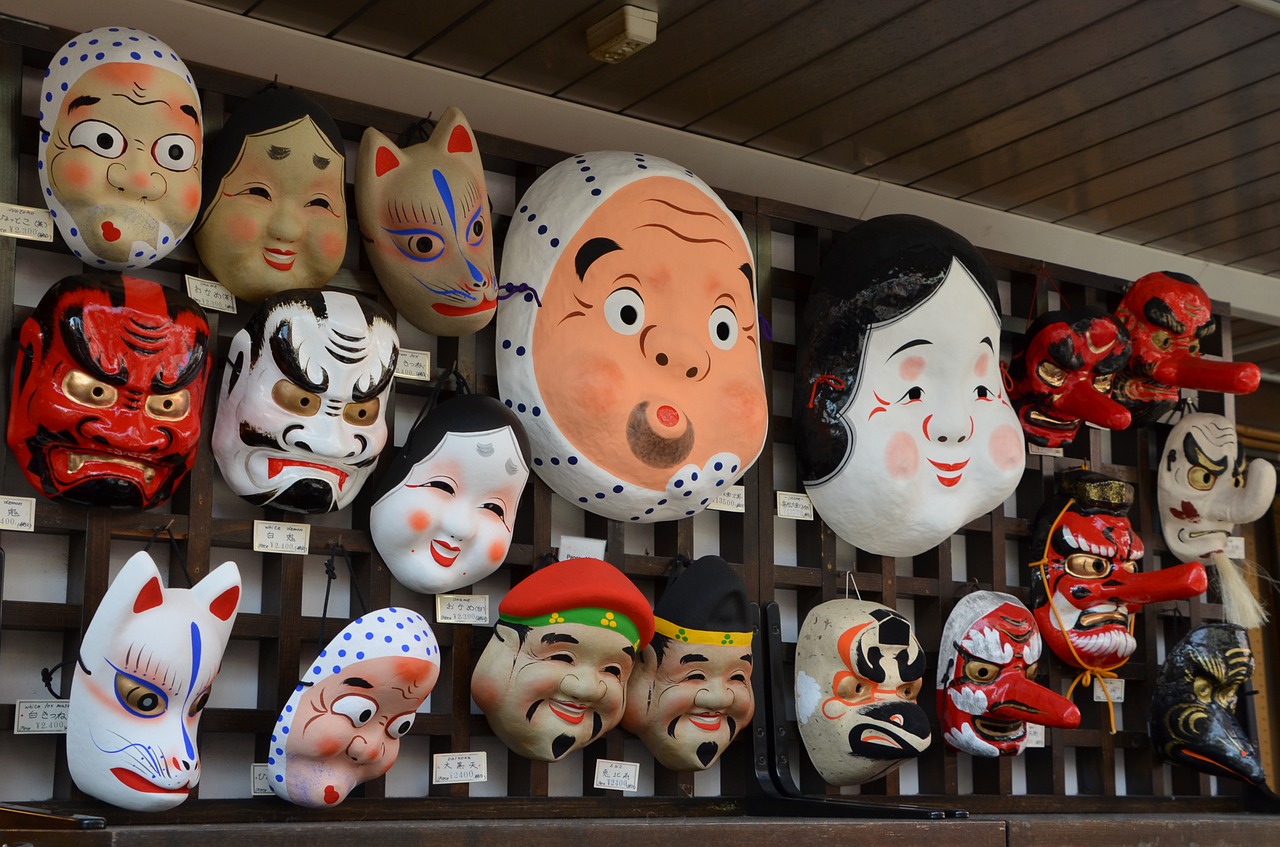
Neko Figurines
Neko is the Japanese word for cat. Before you ask, we are not advocating that you bring a real cat from Japan, but a maneki-neko, a beckoning cat which is a Japanese figurine meant to bring luck. They are usually white cats with red elements and a paw upwards, positioned at the entrance of stores and homes.
The actual origins of the maneki-neko are uncertain (some believe they originated in Tokyo, while others believe they originated in Kyoto). There are many interpretations of the meaning of maneki-neko. Some state that the cat looks as if it’s washing its face with the paw and that means a visitor will arrive soon. Chinese proverbs suggest that a cat washing its face means it will rain. And so, some thought that the cat will bring in many customers in a shop.
Food & Drink
Souvenirs from Japan for foodies? The good news is that everything in Japan looks and tastes remarkable. If you visit a department store, you can even get your precious items wrapped to perfection. I think the beauty of Japanese souvenirs is that everything looks so wonderful.
The joy of getting something from Japan is the art of unwrapping it and delicately unravelling what is in the box. It’s almost as if the anticipation of unboxing something sure ads to the excitement.
Matcha sweets
In Japan, you will find matcha everything. Matcha sweets, matcha food, matcha tea, matcha ice cream. Matcha tastes delicious and is a bit bitter-sweet. Essentially, matcha is ground green tea. We bought so many matcha sweets, it’s unreal. We found that getting sweet items are the best gifts from Japan, as everyone enjoys experiencing a destination through food.
We recommend buying matcha mochi as an easy gift. The box looks great, and it takes up very little space. Mochi tastes lovely, and it is a very unusual type of sweet.
Rice Crackers
Rice crackers taste so, so good in Japan. We recommend getting the soy rice crackers in a shape of a cute animal. We found several boxes of rice crackers, but my favourite was a set bought from Fushimi Inari Shrine, in the shape of small turtle snacks.
Jams
We tasted several jams on Shijo Dori in Kyoto and gosh, don’t they taste incredible? The only downside to bringing jams from Japan is that they take a lot of space, and they are in glass jars, so they need to be well-wrapped before putting them into your luggage. Nevertheless, we bought mandarin and plum jams because they were just too yummy.
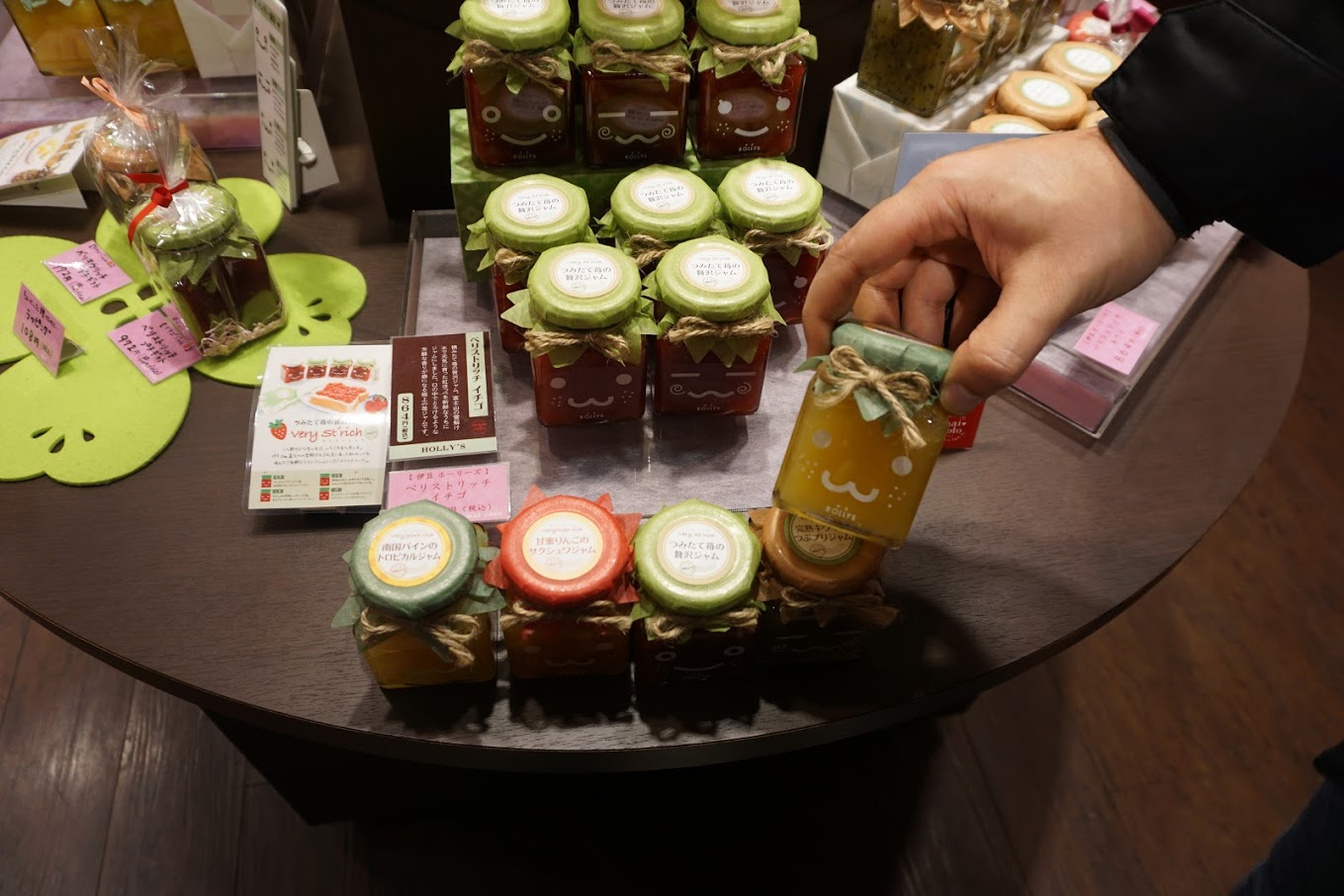
Pickle plums
Plums, or ume in Japanese, taste absolutely delicious when pickled. It’s not your ordinary items in a menu, I know, but we tried them and our taste buds exploded with happiness. You can find small cans or little airtight bags with pickled plums in them.
These are very affordable and a truly unusual gift from Japan.
Salted Sakura
There is a wide range of sakura flavoured things in Japan. After the Japanese cherry blossom festival, sakura flowers are eaten raw or salted. In most markets you can find salted sakura flowers all year around. These used for decoration purposes like in certain Tokyo restaurants, you will find them alongside pickled items.
Pick a bar of sakura chocolate, a packet of sakura buscuit or Yamasan Sakura Candies, these are delicious and don’t take up too much space in your luggage.
Japanese Teas
You can get matcha from Japan, especially if you happen to visit Uji. Uji is believed to be the birthplace of Japanese tea, so there is something really romantic about purchasing matcha right from the source. However, there is more to tea in Japan than just matcha. Try sencha one of the most interesting green teas in the world. And if you are curious about Japanese teas, why not attend a tea ceremony to understand a little more about the ceremony and the Japanese tradition. Often, the best souvenirs from Japan are the memories you make with your loved ones.
Genmaicha is my personal favourite, which tastes a bit like brown rice. Hōjicha is what you will experience in most Japanese restaurants when unlimited tea is included. Don’t forget to try Ume-Kombucha, a ground tea which combines the taste of plum and seaweed, an absolute treat.
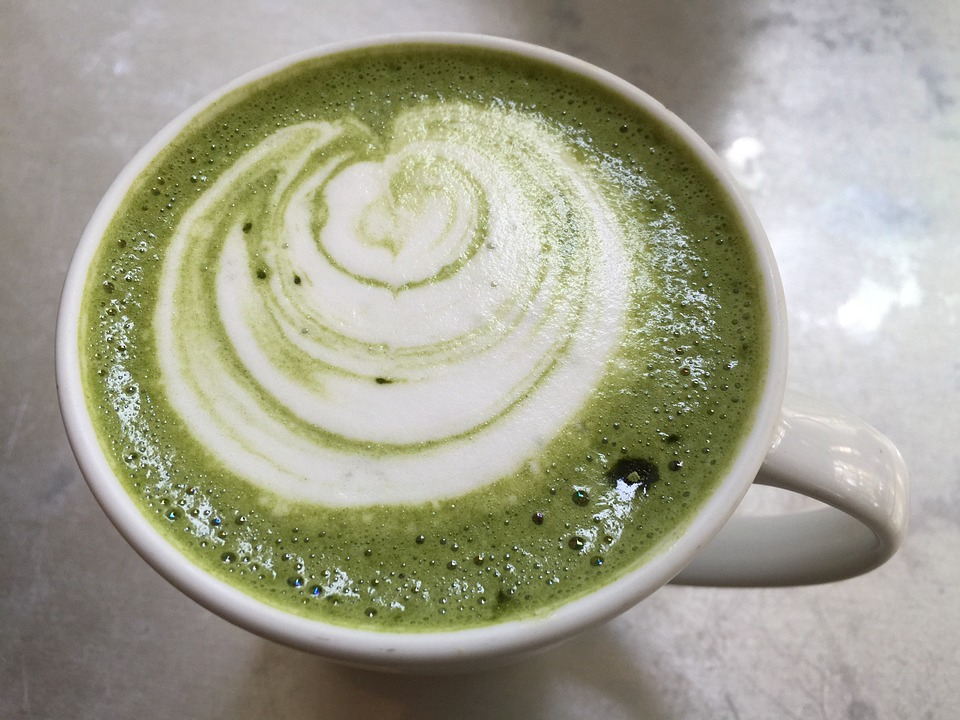
Seaweed from Japan
I don’t mean fresh seaweed, but the dried one you can buy in any supermarket. Get some nori sheet for sushi making or some wakame, which tastes best when it’s served as a salad. We purchased ground nori to add as extras to our rice and Japanese dishes. It’s an unusual but very delicious souvenir from Japan. If you want to sample it first, then make your way to the Tokyo markets and try some Japanese street food. Octopus balls, for example, come with ground nori on the top. The sea taste, gives the dish a fantastic flavour, making it an absolute treat. Many Asian countries use ground seaweed to sprinkle over rice.
Black Sesame
I don’t know why, but we found sesame to taste so much better in Japan than anywhere else in the world. We especially loved black sesame seeds, so we made sure to purchase a few bags of it. You can find some in special Asian supermarkets all around the world, but in Japan, it simply looks better because of its exquisite packaging. If you decide to replicate some Japanese sushi at home, you will definitely need black sesame. As you might have seen in certain restaurants, some California rolls come with black sesame on the rice. It’s a great souvenir from Japan.
Mochi
Want to sweeten someone? Then buy them mochi from Japan, one of the best desserts in the whole world. Ah, we must have put so much weight during our stay in Japan. Don’t go for matcha mochi, but buy something different like sweet potato mochi, mango and cream mochi or red bean mochi. It doesn’t take much space and the packaging is always beautiful. The Japanese know how to package their merchandise, that’s for sure. Often well priced, mochi is a fantastic souvenir from Japan thanks to the almost always luxurious packaging.
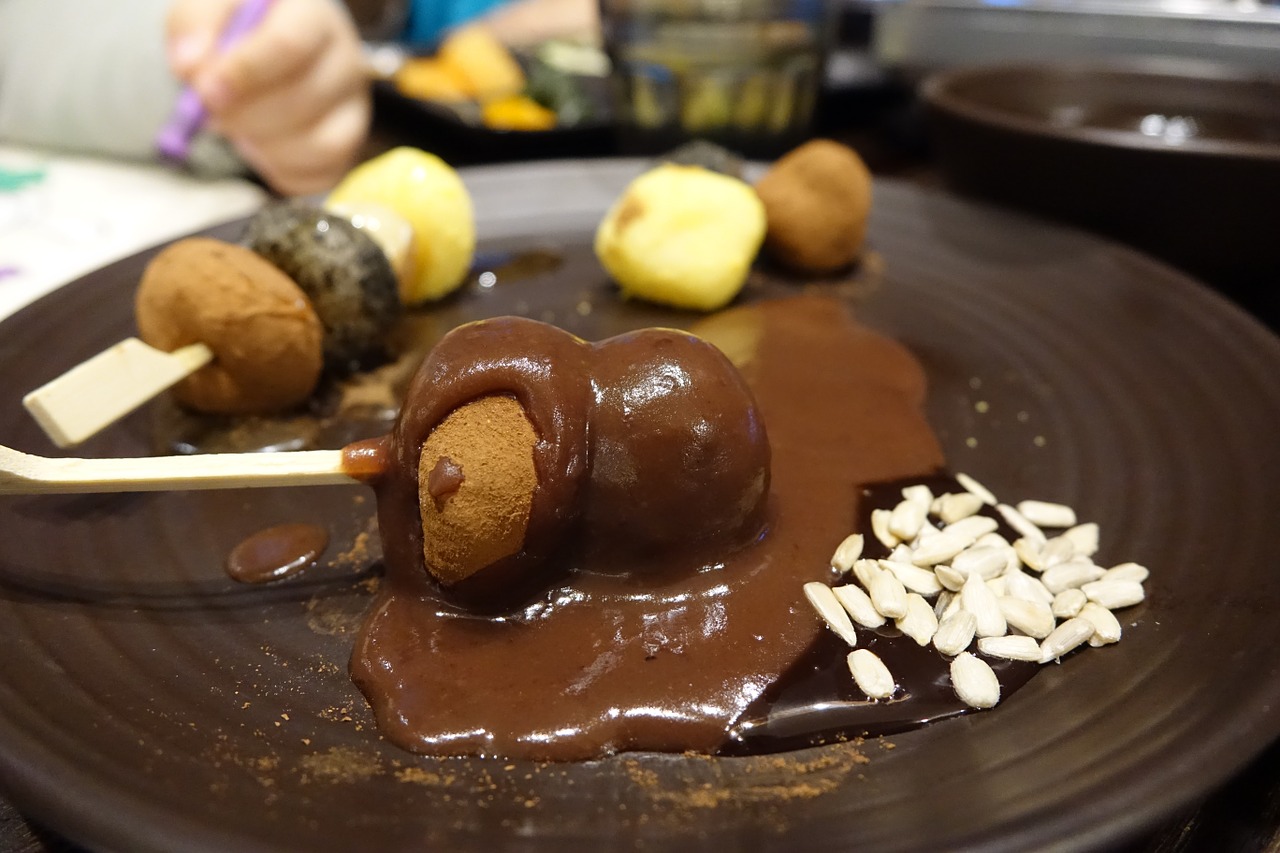
Box of Wagashi
Wagashi is a type of Japanese confectionery, usually served with tea during tea ceremonies. They look incredible and they are always done to perfection. They are usually plant-based and are made of mochi, Anko and fruits. They can be purchased in a box and offered as a present. Exquisite boxes of wagashi can be quite pricey. Again, this is a wonderful Japanese souvenir, and that’s because the box itself is usually stunning. Also, good wagashi is handmade, so even more reasons to celebrate Japanese traditions.
Jellies
I know what you’re thinking: why would I buy jelly from Japan? Well, because it’s delicious! It actually tastes like fruit juice. Banana foams taste real, grape jellies taste like an explosion of sweet fruit juice. Besides, they actually look extraordinary, and their packaging is amazing.
For budget souvenirs from Japan, you can go to any budget store available on most main streets and purchase grape jellies. They are cheap and incredible. We recommend going for the grape jelly, which honestly resembles the real thing.
When we did a comprehensive Tokyo itinerary, we found that some supermarkets in the main subway station sell premium jellies, which look like a mini version of the fruit they meant to taste like. The texture is superb and the taste is nothing but perfect.
Sake from Japan
Finally, no trip to Japan is complete without getting some sake right from the origin. Sake looks so beautiful because in Japan, everyone wants to create beautiful packaging. So, no matter what sake you go for, you are guaranteed to impress. If you buy sake as a souvenir for a friend who loves fancy booze, go for Dassai sake. What makes Japanese sake so special? Although it is essentially rice wine, Japan also uses sake for special celebrations and tea ceremony. The oldest sake brewery is in Kyoto.
While in Japan, you can also visit sake breweries near Nikko. Note that while there is no entry fee to visit the brewery and see how sake is made, you can support the local business by purchasing a bottle of sake as a wonderful Japanese souvenir to remember.
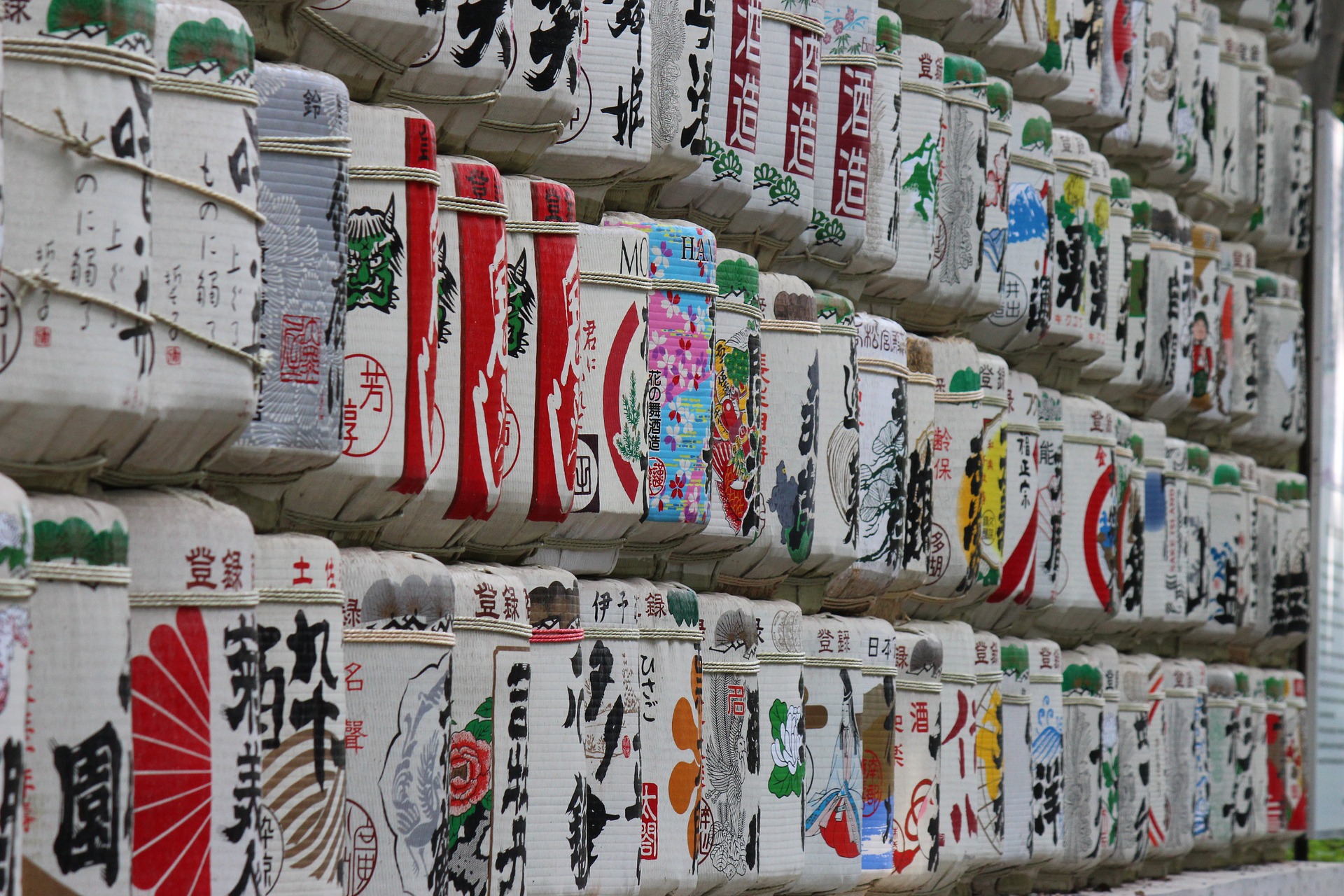
Japanese whisky
Did you know that Japan has some of the best whisky in the world? It actually tastes incredible and it’s becoming a world sensation. This makes a great souvenir from Japan for a more sophisticated friend who loves to enjoy a glass of whisky in front of their fireplace. The first-ever Japanese distillery is Yamazaki which opened in 1924. However, the whisky production began sometime around 1870. If you need to pick a Japanese whisky, note that Suntory and Nikka are two of the best and perhaps the most well known. Yamazaki is still in function today and it creates the Suntory whisky.
Japanese umeshu
I love plum wine and Japan knows how to make the sweetest, most incredible plum wine in the world. We bought a couple of bottles from Choya and we continue to order it online as it’s one of the best drinks we’ve ever had. Umeshu, while referred to as plum wine, is actually a Japanese liqueur made by steeping ume fruits. The best way to enjoy umeshu is on rocks, much like a whisky.
Japanese Stationery
Before you go into any stationery shop in Japan, please make sure you clear your schedule. We mean this. We went to Loft in Tokyo and what suppose to be a 5-minute scout, turned into a 6-hour shopping experience. Everything (and I mean literally everything) was mesmerizing. I mean, these guys even have tiny little boots as toothpaste holders. They have stickers for everything, cute erasers, adorable little holders… I was so happy, I wanted to cry. Buying stationery in Japan is one of the best experiences known to mankind. You might be sceptical now, but wait until you visit Loft.
Erasers
Erasers in Japan are in the shape of super cute and adorable animals. I can’t imagine how exciting it must be to get new stationery as a child in Japan.
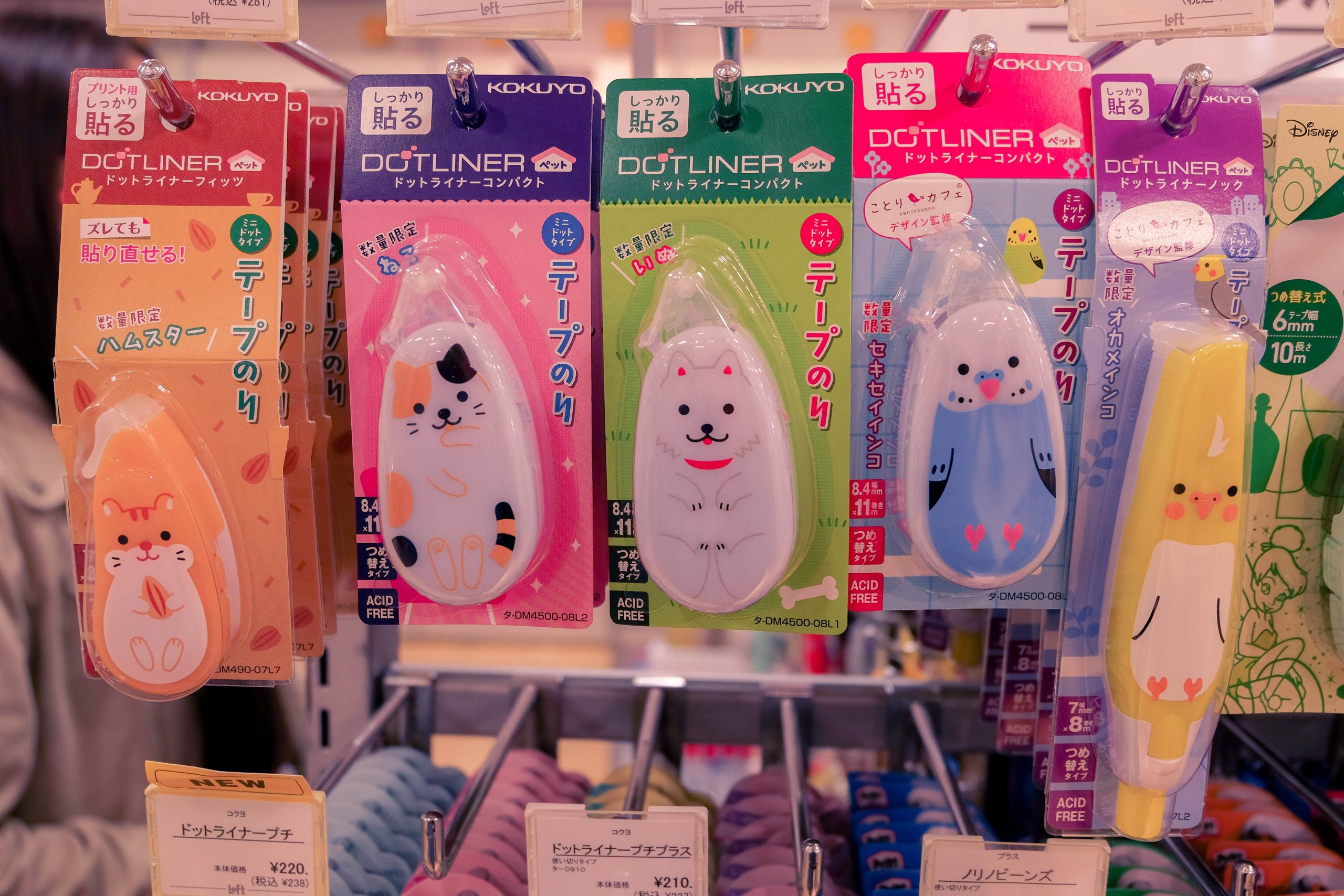
Pen Holders
Pen Holders in Japan are adorable. You can find them in the shape of cute animals or cute characters. Essentially, stationary in Japan is all kawaii. If you have friends with kids, definitely hit the stationery stores for awesome souvenirs from Japan.
Pens and pencils
Not only pens and pencils in Japan are remarkable, but they also have some special rubber tops which you can attach to your items to personalize them and make them more awesome. You can get them all in Loft.
Cute clips
Can you even begin to imagine a cute paper clip? No, me neither, until I saw them in Japan: these guys are so cool, they manage to transform something banal and boring like a paper clip into a super cute item which you want to buy and use all the time.
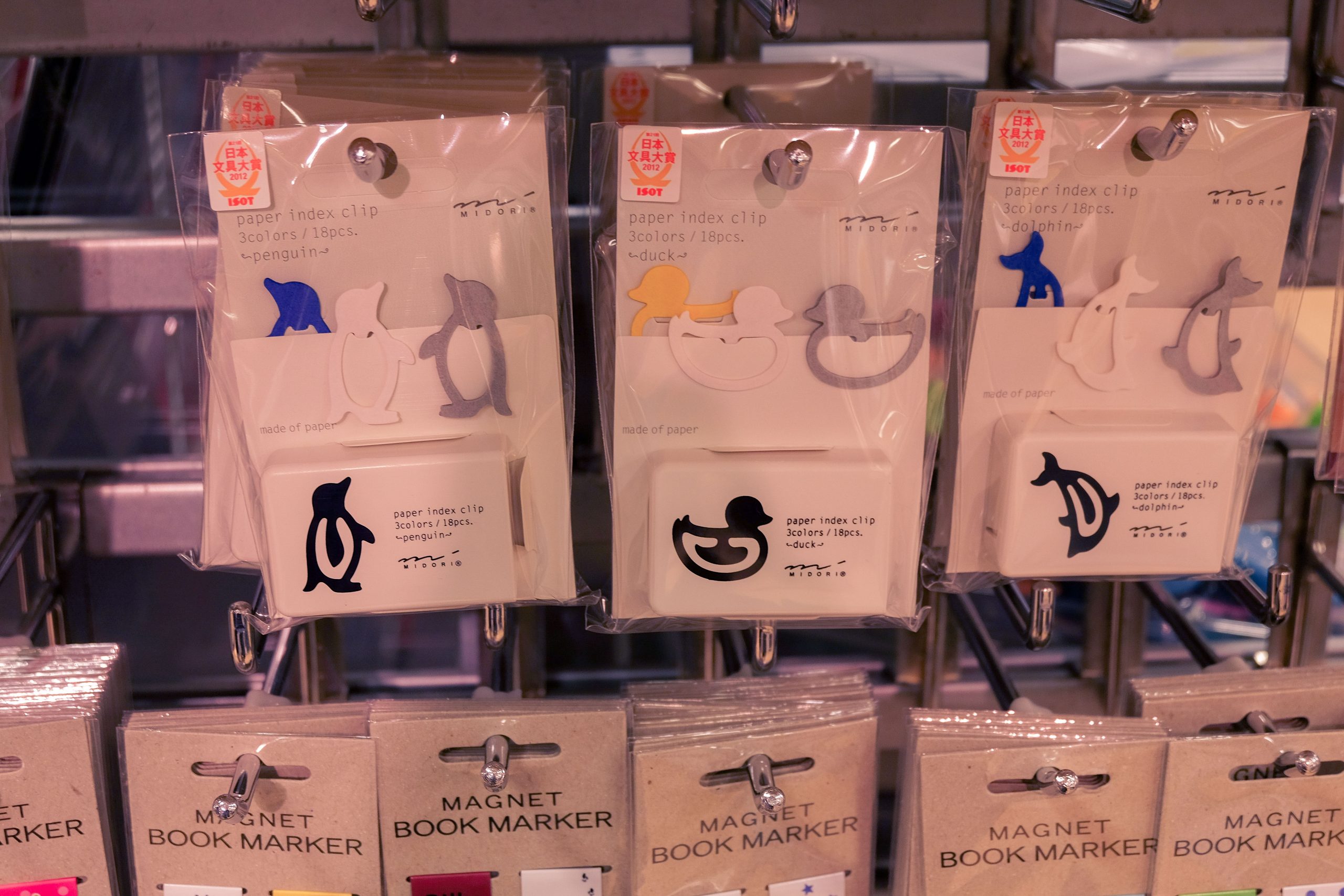
Stickers
In Japan, stickers are everything. There are rows upon rows of different stickers you need to get for your books and agendas. We purchased several stickers for ourselves and for our work colleagues.
Check out B-Side Label in Omotesando, they have 1000s of stickers, labels, and other fun items.
Kitchen Items
I hope you still have room in your luggage because we are far from being done with all the souvenirs from Japan. Next, are the kitchen items which are essential. When wondering what to buy from Japan, kitchen items should be on the list.
We found several stores in Asakusa which sell cheap kitchen items. We already covered Japanese knives above, so we are not going to repeat it here, but we think is one of the coolest things to purchase in Japan.
Ramen Bowl
Once you have your trip to Japan, you’ll come back wanting to eat only Japanese food. We are not even joking. It took me years to learn how to make good ramen and it’s still difficult with some of the ingredients here in Europe. Ramen bowls are a must if you start cooking Japanese food at home. They are usually inexpensive and quite essential in our kitchen.
Sesame Suribachi
Suribachi is a grinding bowl like a mortar and pestle. They are used to grind and crush various items like sesame seeds. Because of their inner ridges, items are being crushed a lot easier than with a traditional mortar and pestle. Besides, they are usually tiny and super cute.
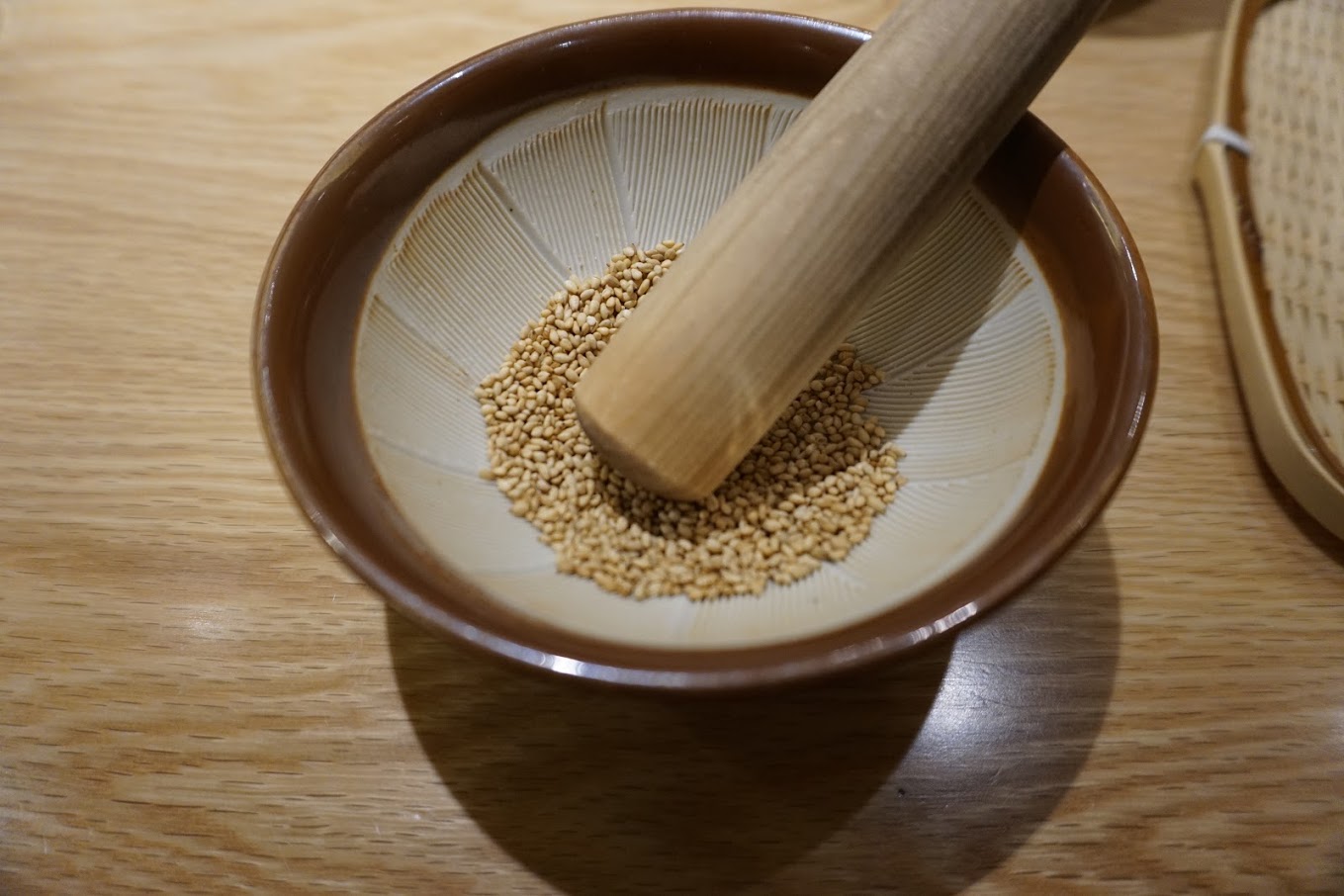
Miso Bowl
Miso soup is served with almost everything in Japan, and it’s one of my favourite things to eat at home, even for breakfast. It’s best served in those black and red miso bowls, which are inexpensive and small enough to be carried back home. They look very nice and make great souvenirs from Japan.
Steamer
A bamboo steamer is used for dumplings. You can get them in the West as well, but we bought ours from a small shop next to Ueno park. We wanted something unusual from Japan, so we thought this will be an interesting thing to buy. Note, that they are fairly large, so think about your suitcase first.
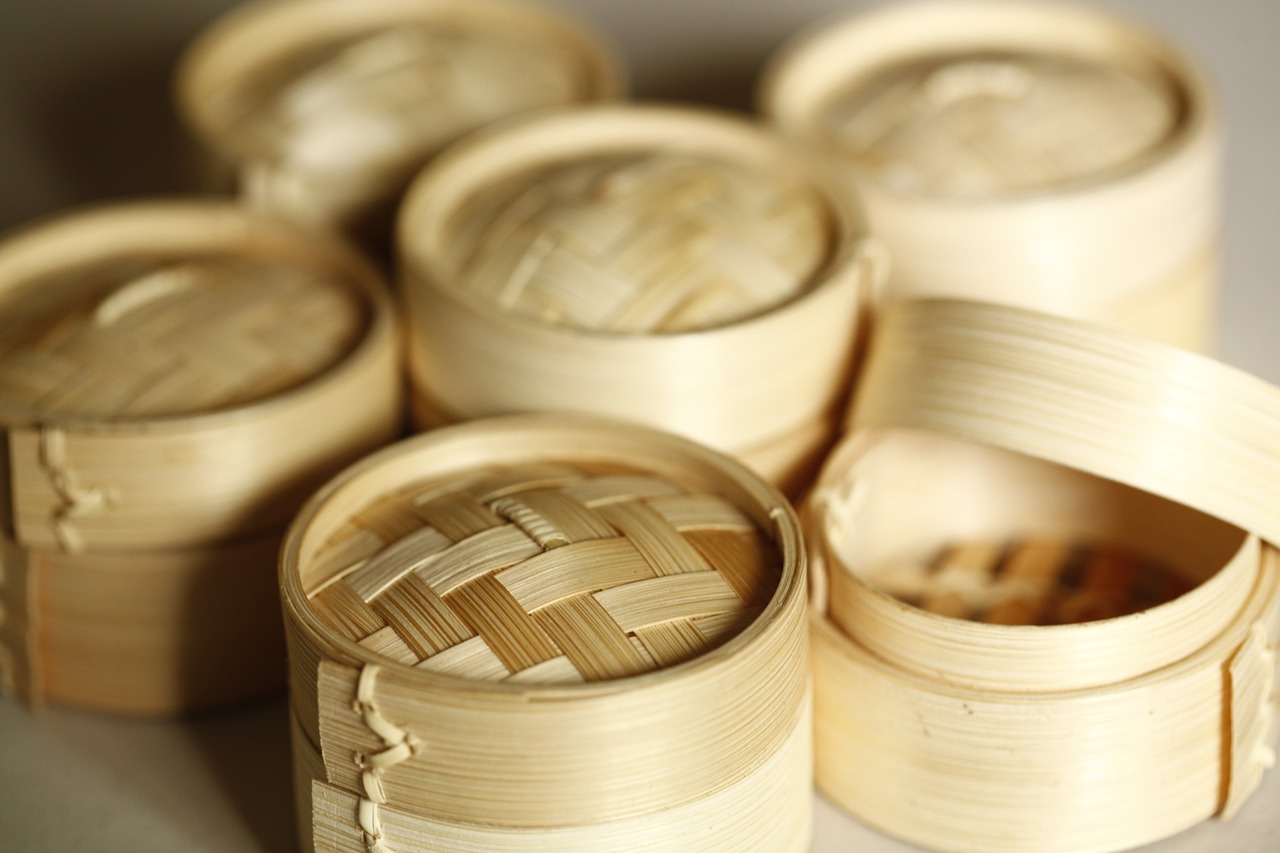
Tea Holder
Can you imagine that in Japan, you can buy cute tea bag holders? They are usually small animals which act like sieves or actual holders. Imagine a cute little cat in your tea. It’s the only country in the world which takes such mundane objects and transforms them into exciting items you want to use all the time.
Bamboo chopstick holder
Japanese etiquette is important, and that’s why you should invest in chopstick holders. The idea is to keep the chopstick tips off the table to prevent used chopsticks from contaminating or falling off the table. You can get origami chopstick rests or some made from yew or bamboo. Since you can find some in various cute shapes, we think they are great as souvenirs when offered with a matching pair of chopsticks.
Sake cups
Sake cups are tiny and adorable. They are usually made from porcelain, and sake can be enjoyed in many vessels. Sakazuki is the oldest sake style cup, but our favourite is the Guinomi as it’s made of porcelain and earthenware. It also looks great and stylish. Most restaurants will serve sake from Ochoko, a modern set which usually has some blue and white design on the bottom or on the inside of the cup.
Cute Japanese plates
For Japanese tableware, you should visit Ginza where you can find a variety of places to buy ceramics from. Prices in Ginza are quite high, but the items are of outstanding quality. If you wish to purchase budget items, you can head to Asakusa to Kappabashi Dogu Street.
Bowl tops
We are not advocating that you purchase ordinary bowl tops, but some cute Japanese ones. Let us explain. In Japan, you can find silicon tops for your bowls, pots, and pans which actually resemble cute animals like dogs, cats, cows, ducks etc. They are meant to make your fridge look a lot more fun and to encourage you to actually store your leftovers. We thought they look brilliant and fun.
Special Japanese Items
I didn’t quite know in which category to add these items, but I know for a fact you will find them not just cool, but also useful. These are the special souvenirs from Japan, which we sometimes order online when we run out. For instance, the best eyeliners on the planet were from Japan. I continue to order it every two months. Face masks in Japan are also really great and there are some essential winter items which I can’t live without.
Anime figurines
These are not your ordinary souvenir, but we wanted to add it to the list. I was a huge Sailor Moon fan as a child, so I couldn’t resist not getting my figurine. There are shops with so much anime merchandise, it’s unreal. If you love anime, then Japan will be the most exciting place on the planet.
Heat Patches
Have you ever wondered how those Japanese girls can withstand freezing temperatures without wearing tights? I now know the secret: heat patches. These are the most amazing Japanese invention ever. You simply add them to your clothes and keep you warm for hours on end. How incredible is that? I adore them and I always buy a suitcase full of them. You can find them in almost all pharmacy in Japan.
Eyeliner
I love wearing black eyeliner and for a very long time, I searched for the perfect eyeliner which doesn’t smudge. When we visited Tokyo, I misplaced my eyeliner one evening, so I had to buy a new one from a random store in Japan. Turns out, I purchased the best eyeliner money can buy. It cost £10, and it lasts for up to 2 months if used daily. It doesn’t smudge at all and doesn’t lose any of its intensity. It’s literally magic. As I don’t live in Japan, I still buy it online.
Mascara
The best mascara I bought? You guessed it, from a store in Japan. The same brand as my eyeliner, Heroine Make, I have the Isehan Kiss me Mascara. It’s so, so good. It actually curls my lashes and lasts a lot longer than any other mascara I ever bought. For your girlfriends, the eyeliner, and mascara have to be the best souvenirs from Japan.
Toe Socks
How about we forget about conventional socks, and we start buying socks with toes? Toe socks are better at keeping your feet warm in the winter. Besides, they look incredibly cute, so it’s a win-win situation. Toe socks resemble gloves but for your feet. They come in many colours with kawaii all over them.
Face Masks
Face masks in Japan are a lot easier to use than in the West. They are an individual sheet full of moisture and active ingredients. You put it on your face, and it moulds properly around your nose, eyes and lips, you wait 10 minutes, and you simply get rid of the sheet. It’s a lot easier and more convenient for travel.
Kawaii Souvenirs from Japan
Finally, the best souvenirs from Japan have to be cute items. Everyone loves cute, and kawaii items in Japan are the bomb. Same as stationary, you can spend hours upon hours just searching through kawaii items. It’s a never-ending shopping experience. Here are some of the cutest items we found in Japan.
Phone cover
Our phone covers were bought from Japan. I mean, who can resist a cover in the shape of a smiling cactus? Or those cute bear ones? Point of the matter is, everyone has a smartphone and everyone needs a kawaii phone case from Japan.
Cute outfits
This is more for girls interested in fashion. Harajuku is well known for its vibrant Takeshita street, perfect for cute shopping opportunities. This is the place to buy those long cat socks, cute skirts and adorable hair accessories.
Plush Toys
You can find so many plush toys in Harajuku. All of them have adorable and unimaginable shapes. I mean, I don’t think I ever thought about buying plush toys in the shape of a toaster. But somehow, Japan managed to make even the most ordinary objects seem like fantastic items everyone wants and needs in their home.
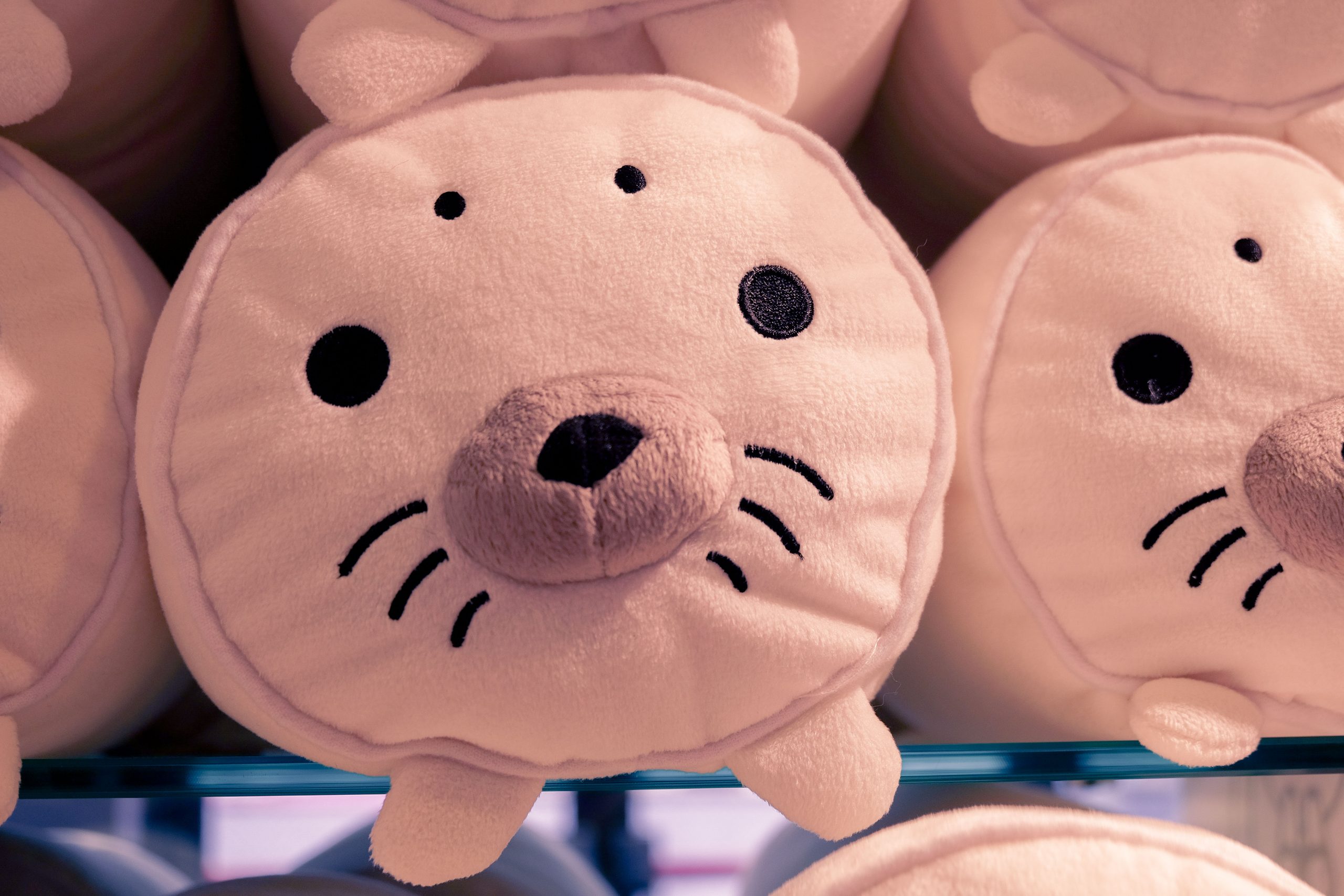
Squishies
Kawaii squishies are a real thing. They come in various shapes and sizes, and some of them even release a special scent when played with. These are items which you can have on your desk and act as great stress releasers. They are basically your cute version of a stress ball.
Vibrant Hair Dye
Want to have an interesting kawaii experience? You can find a lot of temporary dye in Japan. I bought a pink and lavender temporary hair dye from Loft and was really pleased with the results. It’s a fun way to colour your hair in just 5 minutes, then get rid of the colour once you wash your hair the next day.
Hair accessories
Like many items in Japan, hair accessories are incredibly cute. Just head to Takeshita street and buy yourself an array of hair accessories which are cute and colourful. They are great souvenirs from Japan for those friends and families with younger girls who love fun clips and hairpins.
These were our top 61 souvenirs from Japan we think you should get. Japan is a shopping destination, and we promise, you’ll find so many cool things to buy. Our advice is to travel with an empty bag as that will get filled, quickly, whilst discovering Japan.
What souvenirs from Japan did you get? Please let us know in the comments section below.
Frequently Asked Questions
What gift should I buy in Japan?
When visiting Japan, there are many unique and traditional gifts you can consider buying.
Japanese tea: High-quality green tea, such as matcha, sencha, or gyokuro, is always appreciated.
Japanese sweets (Wagashi): Wagashi are traditional Japanese confections often made from natural ingredients such as rice flour, sugar, and sweet red bean paste (anko).
Sake: Sake is a traditional Japanese alcoholic beverage made from fermented rice. Purchase sake that comes in attractive packaging. Go for Ginjo-shu, a premium sake made from rice that has been polished to remove at least 40% of the outer layer or Daiginjo-shu, a super-premium sake made from rice polished to remove at least 50% of the outer layer.
Japanese ceramics: Japan has a long history of producing beautiful ceramics, such as tea sets, bowls, plates, and vases.
Furoshiki: A versatile Japanese wrapping cloth used for wrapping gifts, carrying items, or as a decorative piece.
Chopsticks: Wooden or lacquered chopsticks, typically with intricate designs, make for a practical and beautiful gift.
Omamori: Japanese amulets sold at shrines and temples, believed to provide protection or bring good luck.
Yukata: A casual summer kimono made from cotton, available in various patterns and colours.
Sensu: A traditional Japanese folding fan, often decorated with beautiful designs and artwork.
Tenugui: A thin, rectangular cotton towel with various patterns and uses, such as a hand towel, headband, or wrapping cloth.
Origami paper: Colourful and patterned paper used for the traditional Japanese art of paper folding.
For premium food gifts, head to a depachika, a Japanese food hall, that curates Japan’s finest foods. For other traditional gifts, head to a premium department store in places like Ginza or Nihonbashi.
What can I take home from Japan?
Here’s a list of 15 items that you can take home from Japan, which are unique and representative of Japanese culture:
Chopsticks: Beautifully crafted wooden or lacquered chopsticks make for a practical and elegant gift.
Daruma: Traditional Japanese dolls modelled after Bodhidharma, the founder of Zen Buddhism. They are considered symbols of perseverance and good luck.
Kimono & Yukata: Traditional Japanese garments, with kimono being more formal and yukata being a lighter, more casual option.
Matcha and Sweets: High-quality green tea, such as matcha, and Japanese sweets like wagashi that use matcha as a key ingredient.
Japanese Stationery: Japan is known for its high-quality and beautifully designed stationery items, such as pens, notebooks, and unique writing tools like brush pens or calligraphy sets.
Maneki Neko: The “beckoning cat” is a popular Japanese figurine believed to bring good luck and fortune to its owner.
Japanese Pottery: Japanese ceramics, including tea sets, bowls, plates, and vases, showcase the country’s long history of craftsmanship.
Wasabi Snacks: Unique snacks flavoured with wasabi, such as wasabi peas or wasabi-flavoured rice crackers (senbei).
Noren Curtain: Traditional Japanese fabric dividers used to separate spaces or as a decorative piece, often featuring beautiful designs or calligraphy.
Omamori: Japanese amulets sold at shrines and temples that are believed to provide protection or bring good luck.
Japanese Whiskey: Japan has become renowned for producing high-quality whiskey, so a bottle of Japanese whiskey can make for a special gift for connoisseurs.
Koinobori: Decorative carp-shaped windsocks flown during Children’s Day celebrations in Japan. They symbolize strength, determination, and the hope for a bright future for children.
Gachapon: Capsule toys from vending machines found all over Japan. They often feature popular characters from anime, manga, or video games and can make for fun, collectible souvenirs.
Traditional Japanese Games: Consider bringing home a traditional Japanese game, such as a Go set, Shogi (Japanese chess), or Hanafuda (Japanese playing cards).
Furoshiki: A versatile Japanese wrapping cloth traditionally used for wrapping gifts, carrying items, or as a decorative piece. They come in various sizes, colors, and patterns.
What is a Japanese souvenir called?
A Japanese souvenir is called “omiyage” (お土産). Omiyage are typically small gifts or local specialities that people buy when they travel, to give to friends, family, or coworkers as a way to share their experiences and show appreciation. It’s a deep-rooted custom in Japanese culture and can include food, crafts, or other items unique to a specific region or destination.
What items are famous in Japan?
Japan is famous for a variety of items, ranging from traditional arts and crafts to modern technology and fashion. Here are some well-known items that Japan is famous for:
Kimono and Yukata: Traditional Japanese garments that showcase the country’s rich textile history and craftsmanship.
Japanese Pottery and Ceramics: Renowned for their beauty and functionality, Japanese pottery includes tea sets, bowls, plates, and vases.
Folding Fans (Sensu) and Paper Umbrellas (Wagasa): Traditional Japanese accessories featuring intricate designs and craftsmanship.
Samurai Swords: Also known as katanas, these swords symbolize Japan’s samurai heritage and are renowned for their quality and sharpness.
Electronics: Japan is a global leader in technology and electronics, with brands like Sony, Panasonic, and Nintendo being household names worldwide.
Anime and Manga: Japanese animation and comic books have become popular worldwide, with famous titles like Naruto, One Piece, and Studio Ghibli films.
Japanese Cuisine: Japan is renowned for its food, such as sushi, ramen, tempura, and wagashi (traditional sweets).
Green Tea: High-quality Japanese green tea, such as matcha, sencha, and gyokuro, is enjoyed around the world for its taste and health benefits.
Japanese Whiskey: Japan has gained international recognition for producing high-quality whiskey, often compared to the best Scottish varieties.
Kawaii Culture: Japan is known for its “kawaii” (cute) culture, which can be seen in various aspects of Japanese life, from fashion to advertising and character design.
The Best Souvenirs in Japan?
The absolute best things to buy in Japan are Chopsticks, Kitchenware like ceramics, Japanese knifes, Kimono, Anime figurines, Plush Toys, Wagashi sweets, Tea & matcha, Fruit Jellies
What products are unique to Japan?
These are the products you can only buy in Japan: Kimono & yukata, Wagashi sweets, speciality sake, fruit jellies, ema (from temples & shrines), omamori, special Japanese incense
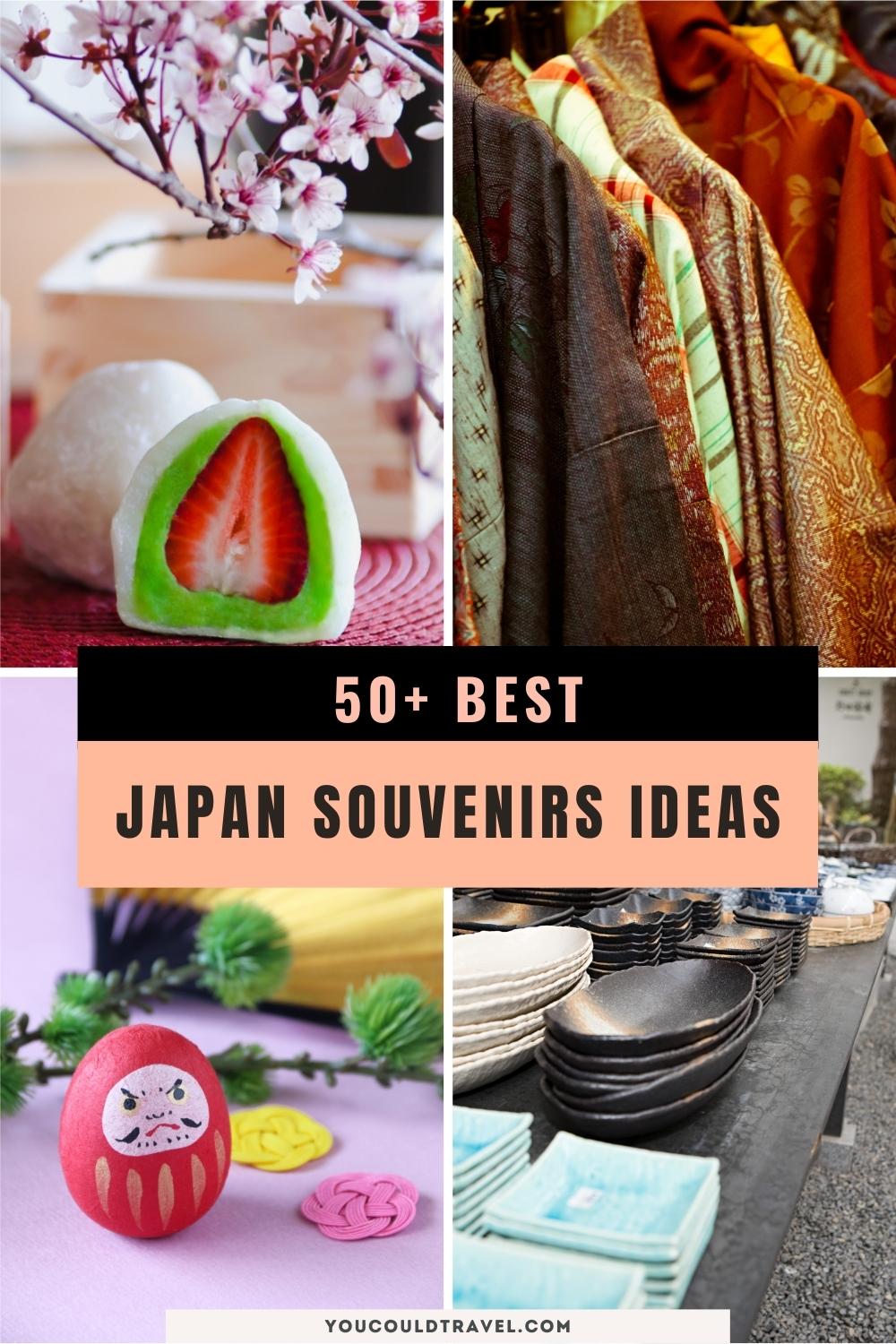
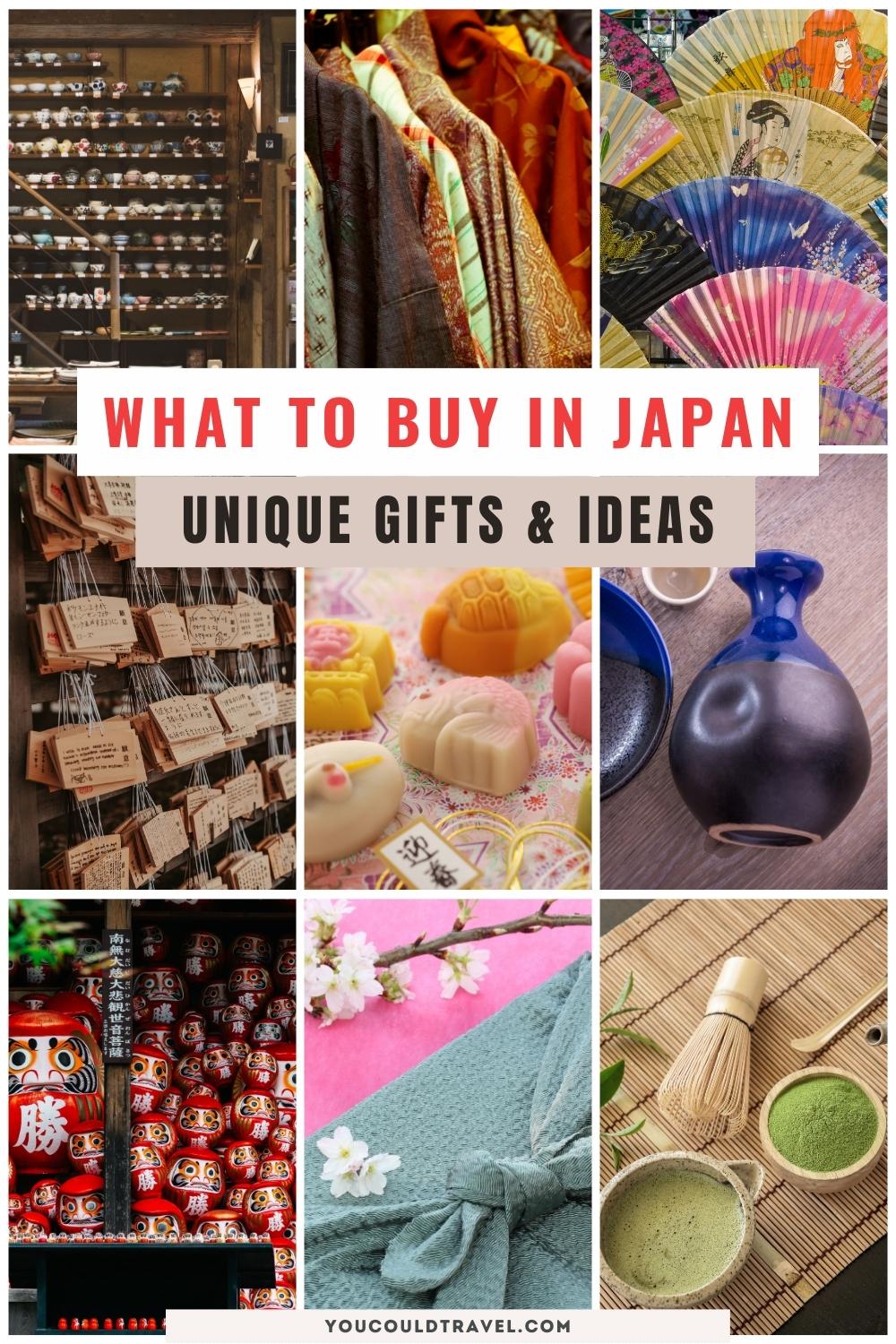

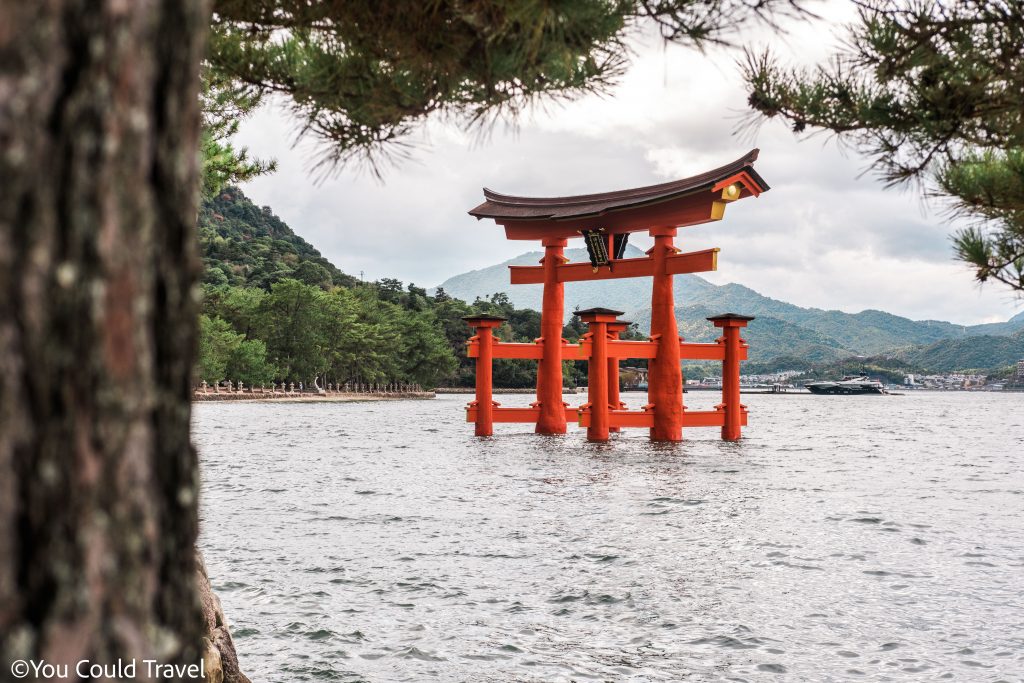
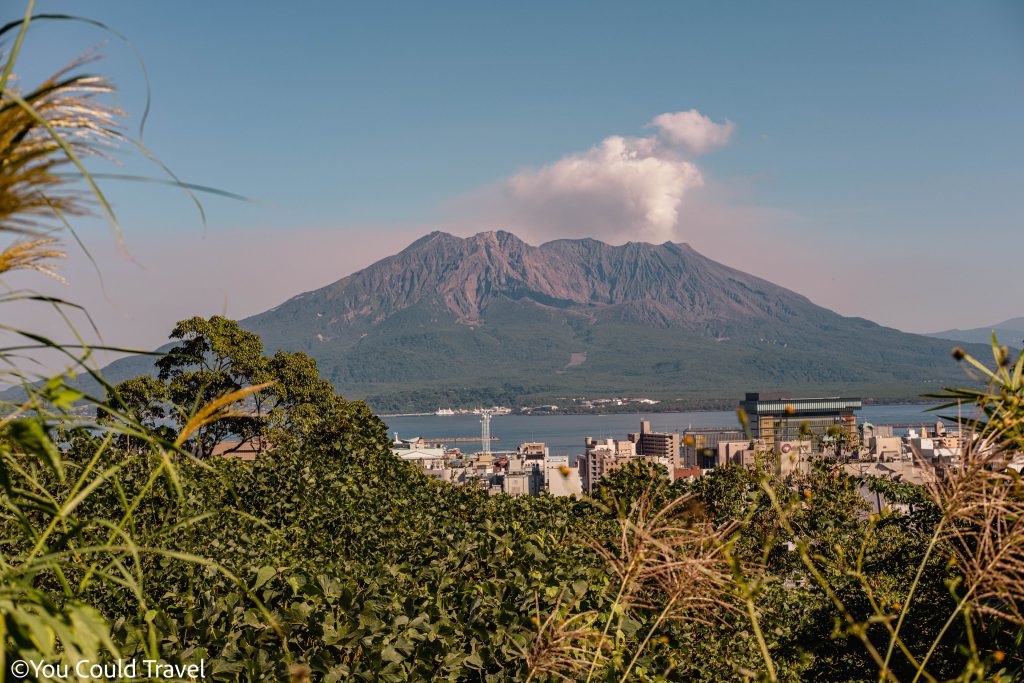
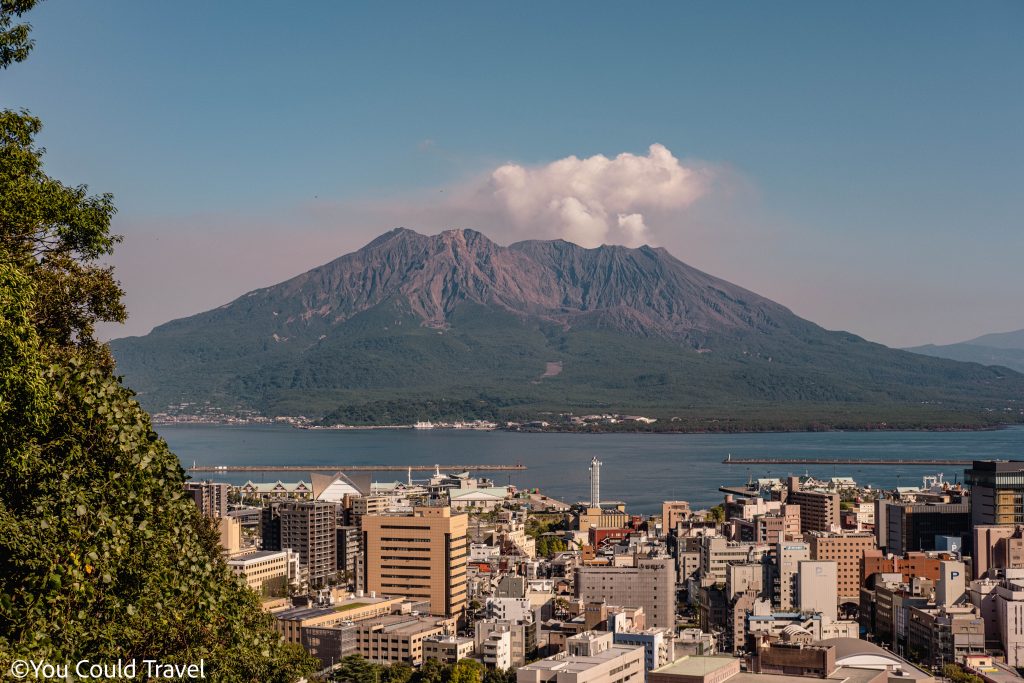

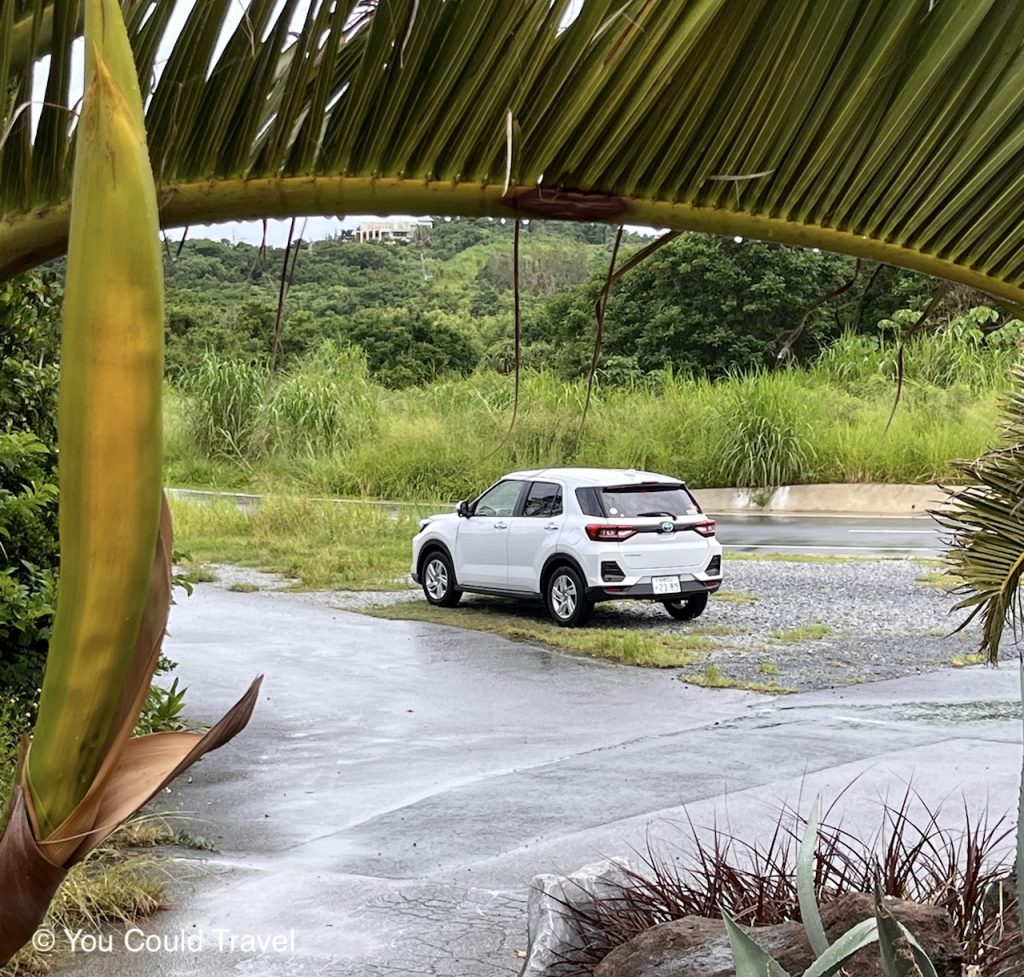



Leave a Reply